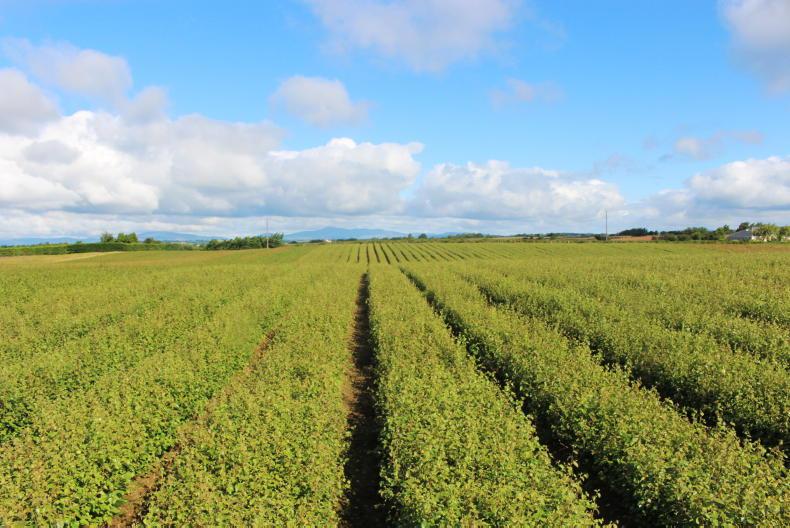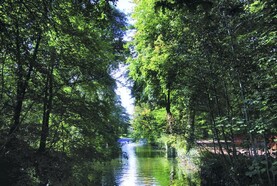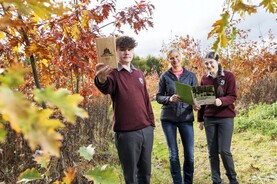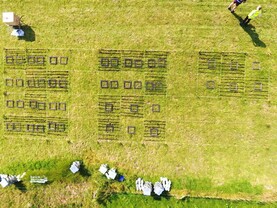Despite the declining interest in afforestation, “over 1,000 applicants are still awaiting a decision from the Department to plant their land which is why the industry has lost all faith in the Department’s licensing scandal being resolved”, maintains Teige Ryan, director of None so Hardy Nurseries.
To achieve the Government’s 8,000ha annual afforestation programme, approximately 40 licences would need to be issued each week by the Department, based on 50% of applicants going ahead and planting in the medium term.
For a variety of reasons, including delays in issuing licences, many applicants lose interest or postpone the decision to plant.
“Afforestation is forgotten by the Department as the latest dashboard figures show less than two licences issued weekly so far in August and a shocking 19 for the month of July,” says Ryan.
“Continued delays in issuing licences will force interested landowners to turn to other land incomes.
“Minister Hackett’s approach for her Department to issue felling licences at an 11:1 ratio over planting licences since June will put nursery survival to the test yet again as it will result in further afforestation decline,” he maintains.
“Instead of highlighting the importance of tree planting to mitigate climate change, and prioritise afforestation licences, the minister’s department has gone in the opposite direction and will actually suppress tree planting in Ireland.”
Nursery production is set to achieve the 8,000ha afforestation required to meet climate action targets but Ryan claims the Department has no intention of preventing further decline let alone increase the “abysmally low” 2,400ha afforestation achieved last year. “In fact, the total for 2021 is likely to see further reduction with only 1,690ha planted to date,” he says.
“The lack of any intent to maximise tree planting is best personified in the minister’s own account to the Joint Oireachtas Committee on 4 August, stating it would be 2023 before 8,000ha would be even realistic.

Retired foresters, Gerry Patterson and Bob Dagg, in Lugduff property, Glendalough forest, beside the tallest tree in Ireland, a 61m Sitka spruce. Both served as State foresters in Glendalough at different times from the 1960s when it was part of the Forest and Wildlife Service, later transferred to Coillte. \ Donal Magner
“From a nursery survival perspective, failure to even acknowledge the potential of the 9,000ha awaiting approval is worrying. This willingness to throw in the towel in planting is also evident in the Department’s dashboard figures.”
Apart from the uncertain future of nurseries, he asks about the negative effect of this approach on Ireland’s climate action obligations (see panel opposite).
While afforestation licences have virtually stalled, Ryan acknowledges that felling and roading licences are also well down.
He calls on Ministers McConalogue and Hackett to resolve the licence issue and “avoid the crazy situation where containers of Ireland’s nursery saplings destined for Scotland meet lorry loads of timber at the ports, coming from Scottish forests, while plenty of available but unlicensed timber remains in Irish forests”.
Both ministers need to acknowledge the interdependency of both afforestation and timber processing to avoid a bleak future, he says.
“The current strategy has created a situation where there are no licences for timber while creating a legacy of no timber to licence.”
Minister replies to questions on missing afforestation targets
When asked by Deputy Brendan Howlin recently about the amount of carbon “his Department has failed to capture due to missing afforestation targets in each of the past five years”, Minister for Agriculture Charlie McConalogue replied: “Over the last five years, there has been a shortfall in meeting targets of 15,365ha. Were this area to be afforested with 70% conifer and 30% broadleaf, these forests had the potential to remove 5.8m tonnes of carbon dioxide over their lifetime and takes into account when forests are felled and replanted.”
Lifetime
In a separate written Dáil question, Deputy Howlin asked for “an approximate tonnage of CO2 sequestered per hectare of afforestation over a typical crop over its lifetime”.
Minister McConalogue replied: “If 1ha of land is afforested with 70% conifer and 30% broadleaf, a typical forest has the potential to remove 377t of carbon dioxide per rotation over the first and subsequent rotations, which is based on a mean annual sequestration rate of 6.9t of CO2 per hectare for the conifer species and 2.3t of CO2 per hectare for the broadleaf species.”
Minister McConalogue based his calculations on Teagasc’s forest carbon tool, which calculates carbon sequestration for a variety of forests crops.
Revisiting the Glendalough Sitka spruce – the tallest tree in Ireland
My first encounter with forestry that rivalled the great global forests I had only read about was in Lugduff property, Glendalough forest, in the 1970s.
Back then, the impressive Sitka spruce and Douglas fir looked ancient until an elderly member of the Glendalough staff told me that he and his fellow workers planted the property in 1933.
When I arrived, the forest workers were still thinning the 39-year-old Sitka for construction timber and extracting Douglas fir to supply large electricity transmission poles.
The Douglas fir and most of the Sitka were clearfelled in the 1980s but thanks to the foresight of the then forester in charge, Bob Dagg, and region manager, Michael O’Brien, a small grove was retained in Lugduff.
This was an important decision, because one of the Sitka spruce has outgrown all other champion Irish trees such as the Douglas fir in Powerscourt, Co Wicklow, and the Sitka spruce in Curraghmore Estate, Co Waterford, both planted a century earlier in the 1830s on soils far more nutrient rich than Lugduff.
Today, the Glendalough Sitka stands 61.6m tall. It is the tallest tree in Ireland as measured by tree enthusiast Aubrey Fennell. Retired foresters Gerry Patterson and Bob Dagg recall discussing the planting of Lugduff with the forest staff who said that it was “filled in” for several years after planting because of damage caused by deer and goats.
The trees are surprisingly slender due to their initial close spacing (1.5m x 1.5m) or 4,400/ha compared with current spacing (2m x 2m) or 2,500/ha.
The period since the 1920s was a remarkable time in Glendalough forestry when highly productive stands of Sitka spruce, Douglas fir, Scots pine and other species were planted in a diverse range of soils and sites – some very exposed on unenclosed land.
Today, virtually all of the majestic forests of Glendalough, Glenmalure and much of Co Wicklow would not be approved for afforestation licences.
The Lugduff stand demonstrates what a beautiful tree Sitka spruce is, especially if given the time to express itself in all its majesty.
Described as the workhorse of Irish forestry, it is testament to the great tree hunters who introduced it from western North America and the generations of foresters and forest workers who planted and nurtured it to play such a vital role in the short but proud history of Ireland’s forests.
Despite the declining interest in afforestation, “over 1,000 applicants are still awaiting a decision from the Department to plant their land which is why the industry has lost all faith in the Department’s licensing scandal being resolved”, maintains Teige Ryan, director of None so Hardy Nurseries.
To achieve the Government’s 8,000ha annual afforestation programme, approximately 40 licences would need to be issued each week by the Department, based on 50% of applicants going ahead and planting in the medium term.
For a variety of reasons, including delays in issuing licences, many applicants lose interest or postpone the decision to plant.
“Afforestation is forgotten by the Department as the latest dashboard figures show less than two licences issued weekly so far in August and a shocking 19 for the month of July,” says Ryan.
“Continued delays in issuing licences will force interested landowners to turn to other land incomes.
“Minister Hackett’s approach for her Department to issue felling licences at an 11:1 ratio over planting licences since June will put nursery survival to the test yet again as it will result in further afforestation decline,” he maintains.
“Instead of highlighting the importance of tree planting to mitigate climate change, and prioritise afforestation licences, the minister’s department has gone in the opposite direction and will actually suppress tree planting in Ireland.”
Nursery production is set to achieve the 8,000ha afforestation required to meet climate action targets but Ryan claims the Department has no intention of preventing further decline let alone increase the “abysmally low” 2,400ha afforestation achieved last year. “In fact, the total for 2021 is likely to see further reduction with only 1,690ha planted to date,” he says.
“The lack of any intent to maximise tree planting is best personified in the minister’s own account to the Joint Oireachtas Committee on 4 August, stating it would be 2023 before 8,000ha would be even realistic.

Retired foresters, Gerry Patterson and Bob Dagg, in Lugduff property, Glendalough forest, beside the tallest tree in Ireland, a 61m Sitka spruce. Both served as State foresters in Glendalough at different times from the 1960s when it was part of the Forest and Wildlife Service, later transferred to Coillte. \ Donal Magner
“From a nursery survival perspective, failure to even acknowledge the potential of the 9,000ha awaiting approval is worrying. This willingness to throw in the towel in planting is also evident in the Department’s dashboard figures.”
Apart from the uncertain future of nurseries, he asks about the negative effect of this approach on Ireland’s climate action obligations (see panel opposite).
While afforestation licences have virtually stalled, Ryan acknowledges that felling and roading licences are also well down.
He calls on Ministers McConalogue and Hackett to resolve the licence issue and “avoid the crazy situation where containers of Ireland’s nursery saplings destined for Scotland meet lorry loads of timber at the ports, coming from Scottish forests, while plenty of available but unlicensed timber remains in Irish forests”.
Both ministers need to acknowledge the interdependency of both afforestation and timber processing to avoid a bleak future, he says.
“The current strategy has created a situation where there are no licences for timber while creating a legacy of no timber to licence.”
Minister replies to questions on missing afforestation targets
When asked by Deputy Brendan Howlin recently about the amount of carbon “his Department has failed to capture due to missing afforestation targets in each of the past five years”, Minister for Agriculture Charlie McConalogue replied: “Over the last five years, there has been a shortfall in meeting targets of 15,365ha. Were this area to be afforested with 70% conifer and 30% broadleaf, these forests had the potential to remove 5.8m tonnes of carbon dioxide over their lifetime and takes into account when forests are felled and replanted.”
Lifetime
In a separate written Dáil question, Deputy Howlin asked for “an approximate tonnage of CO2 sequestered per hectare of afforestation over a typical crop over its lifetime”.
Minister McConalogue replied: “If 1ha of land is afforested with 70% conifer and 30% broadleaf, a typical forest has the potential to remove 377t of carbon dioxide per rotation over the first and subsequent rotations, which is based on a mean annual sequestration rate of 6.9t of CO2 per hectare for the conifer species and 2.3t of CO2 per hectare for the broadleaf species.”
Minister McConalogue based his calculations on Teagasc’s forest carbon tool, which calculates carbon sequestration for a variety of forests crops.
Revisiting the Glendalough Sitka spruce – the tallest tree in Ireland
My first encounter with forestry that rivalled the great global forests I had only read about was in Lugduff property, Glendalough forest, in the 1970s.
Back then, the impressive Sitka spruce and Douglas fir looked ancient until an elderly member of the Glendalough staff told me that he and his fellow workers planted the property in 1933.
When I arrived, the forest workers were still thinning the 39-year-old Sitka for construction timber and extracting Douglas fir to supply large electricity transmission poles.
The Douglas fir and most of the Sitka were clearfelled in the 1980s but thanks to the foresight of the then forester in charge, Bob Dagg, and region manager, Michael O’Brien, a small grove was retained in Lugduff.
This was an important decision, because one of the Sitka spruce has outgrown all other champion Irish trees such as the Douglas fir in Powerscourt, Co Wicklow, and the Sitka spruce in Curraghmore Estate, Co Waterford, both planted a century earlier in the 1830s on soils far more nutrient rich than Lugduff.
Today, the Glendalough Sitka stands 61.6m tall. It is the tallest tree in Ireland as measured by tree enthusiast Aubrey Fennell. Retired foresters Gerry Patterson and Bob Dagg recall discussing the planting of Lugduff with the forest staff who said that it was “filled in” for several years after planting because of damage caused by deer and goats.
The trees are surprisingly slender due to their initial close spacing (1.5m x 1.5m) or 4,400/ha compared with current spacing (2m x 2m) or 2,500/ha.
The period since the 1920s was a remarkable time in Glendalough forestry when highly productive stands of Sitka spruce, Douglas fir, Scots pine and other species were planted in a diverse range of soils and sites – some very exposed on unenclosed land.
Today, virtually all of the majestic forests of Glendalough, Glenmalure and much of Co Wicklow would not be approved for afforestation licences.
The Lugduff stand demonstrates what a beautiful tree Sitka spruce is, especially if given the time to express itself in all its majesty.
Described as the workhorse of Irish forestry, it is testament to the great tree hunters who introduced it from western North America and the generations of foresters and forest workers who planted and nurtured it to play such a vital role in the short but proud history of Ireland’s forests.







 This is a subscriber-only article
This is a subscriber-only article










SHARING OPTIONS: